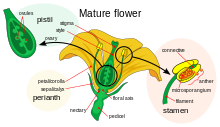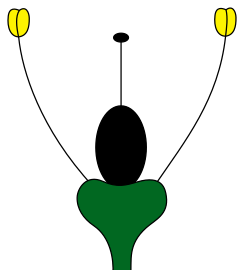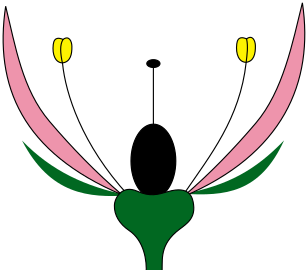Perianth: Difference between revisions
No edit summary |
Tsarivan613 (talk | contribs) m →Corona: Copy editing |
||
| (18 intermediate revisions by 15 users not shown) | |||
| Line 1: | Line 1: | ||
{{ |
{{Short description|Collective term for the sepals and petals, or either of them if one is absent}} |
||
[[Image:Mature flower diagram.svg|thumb| |
[[Image:Mature flower diagram.svg|thumb|A mature flower. In this example, the perianth is separated into a calyx (sepals) and corolla (petals)]] |
||
The '''perianth''' ('''perigonium''', '''perigon''' or '''perigone''' in monocots) is the non-reproductive part of the [[flower]], and structure that forms an envelope surrounding the sexual organs, consisting of the [[ |
The '''perianth''' ('''perigonium''', '''perigon''' or '''perigone''' in monocots) is the non-reproductive part of the [[flower]], and structure that forms an envelope surrounding the sexual organs, consisting of the [[Sepal|calyx]] (sepals) and the [[Petal|corolla]] (petals) or [[Tepal|tepals]] when called a perigone. The term ''perianth'' is derived from [[Greek language|Greek]] [[wikt:περί|περί]] ({{transl|el|peri}}, "around") and [[wikt:άνθος|άνθος]] ({{transl|el|anthos}}, "flower"), while ''perigonium'' is derived from [[wikt:περί|περί]] ({{transl|el|peri}}) and [[wikt:γόνος|γόνος]] ({{transl|el|gonos}}, "seed, sex organs"). |
||
In the [[moss]]es and [[Marchantiophyta|liverworts (Marchantiophyta)]], the perianth is the sterile tubelike tissue that surrounds the female reproductive structure (or developing [[sporophyte]]). |
In the [[moss]]es and [[Marchantiophyta|liverworts (Marchantiophyta)]], the perianth is the sterile tubelike tissue that surrounds the female reproductive structure (or developing [[sporophyte]]). |
||
== Flowering plants == |
== Flowering plants == |
||
{{main|Sepal|Petal|l1=Calyx|l2=Corolla}} |
{{main|Sepal|Petal|l1=Calyx|l2=Corolla}} |
||
In [[flowering plant]]s, the perianth may be described as being either '''dichlamydeous'''/'''heterochlamydeous''' in which the calyx and corolla are clearly separate, or '''homochlamydeous''', in which they are indistinguishable (and the sepals and petals are collectively referred to as ''' |
In [[flowering plant]]s, the perianth may be described as being either '''dichlamydeous'''/'''heterochlamydeous''' in which the calyx and corolla are clearly separate, or '''homochlamydeous''', in which they are indistinguishable (and the sepals and petals are collectively referred to as '''tepals'''). When the perianth is in two whorls, it is described as '''biseriate'''. While the calyx may be green, known as '''sepaloid''', it may also be brightly coloured, and is then described as '''petaloid'''. When the undifferentiated tepals resemble petals, they are also referred to as "petaloid", as in [[Lilioid_monocots|petaloid monocots]] or liliod monocots, orders of monocots with brightly coloured tepals. The corolla and petals have a role in attracting [[pollinator]]s, but this may be augmented by more specialised structures like the '''corona''' (see below). |
||
When the corolla consists of separate tepals the term '''apotepalous''' is used, or '''syntepalous''' if the tepals are fused to one another. The petals may be united to form a tubular corolla ('''gamopetalous''' or '''sympetalous'''). If either the petals or sepals are entirely absent, the perianth can be described as being '''monochlamydeous'''. |
When the corolla consists of separate tepals the term '''apotepalous''' is used, or '''syntepalous''' if the tepals are fused to one another. The petals may be united to form a tubular corolla ('''gamopetalous''' or '''sympetalous'''). If either the petals or sepals are entirely absent, the perianth can be described as being '''monochlamydeous'''. |
||
| Line 13: | Line 13: | ||
{{gallery |
{{gallery |
||
|title=Types of perianth |
|title=Types of perianth |
||
|width=260 |
|||
|align=center |
|align=center |
||
|mode=packed |
|||
|Image:Achlamyde. |
|Image:Achlamyde.svg|Achlamydeous [[Meristem#Floral meristem|floral meristem]] without |
||
a corolla or calyx |
a corolla or calyx |
||
|Image:Haplochlamyde. |
|Image:Haplochlamyde.svg|Monochlamydeous perianth with non-petaloid calyx only |
||
|Image:Homochlamyde. |
|Image:Homochlamyde.svg|Monochlamydeous perianth with corolla only |
||
or homochlamydeous perigonium with tepals |
or homochlamydeous perigonium with tepals |
||
|Image:Heterochlamyde. |
|Image:Heterochlamyde.svg|Dichlamydeous/heterochlamydeous perianth with separate whorls |
||
}} |
}} |
||
| Line 26: | Line 26: | ||
=== Corona === |
=== Corona === |
||
| ⚫ | |||
| ⚫ | |||
| ⚫ | An additional structure in some plants (e.g. ''[[Narcissus (plant)|Narcissus]]'', [[Passiflora|''Passiflora'' (passion flower)]], some ''[[Hippeastrum]]'', [[Liliaceae]]) is the '''corona''' (paraperigonium, paraperigon, or paracorolla), a ring or set of appendages of adaxial tissue arising from the corolla or the outer edge of the stamens. It is often positioned where the corolla lobes arise from the corolla tube.<ref name=Beentje>{{cite book |author1=Beentje, H. |author2=Williamson, J. |year=2010 |title=The Kew Plant Glossary: an Illustrated Dictionary of Plant Terms |publisher=Kew Publishing |location=Royal Botanic Gardens, Kew }}</ref> |
||
| ⚫ | |||
[[File:Ray-floret.svg|thumb|Ligulate floret, typical for some members of the family [[Asteraceae]]:<br/>'''A.''' [[inferior ovary]]<br/>'''B.''' The [[sepal|calyx]] is a crown-shaped [[Pappus (flower structure)|pappus]], called a '''corona'''.<br/>'''C.''' Anthers are united in a tube around the style, though the filaments are separate.<br/>'''D.''' A ligulate petal extends from the tubular corolla.<br/>'''E.''' style and stigmas]] |
[[File:Ray-floret.svg|thumb|Ligulate floret, typical for some members of the family [[Asteraceae]]:<br/>'''A.''' [[inferior ovary]]<br/>'''B.''' The [[sepal|calyx]] is a crown-shaped [[Pappus (flower structure)|pappus]], called a '''corona'''.<br/>'''C.''' Anthers are united in a tube around the style, though the filaments are separate.<br/>'''D.''' A ligulate petal extends from the tubular corolla.<br/>'''E.''' style and stigmas]] |
||
| ⚫ | An additional structure in some plants (e.g. ''[[Narcissus (plant)|Narcissus]]'', [[Passiflora|''Passiflora'' (passion flower)]], some ''[[Hippeastrum]]'', [[Liliaceae]]) is the '''corona''' (paraperigonium, paraperigon, or paracorolla), a ring or set of appendages of adaxial tissue arising from the corolla or the outer edge of the stamens. It is often positioned where the corolla lobes arise from the corolla tube.<ref name=Beentje>{{cite book |author1=Beentje, H. |author2=Williamson, J. |year=2010 |title=The Kew Plant Glossary: an Illustrated Dictionary of Plant Terms |publisher=Kew Publishing |location=Royal Botanic Gardens, Kew}}</ref> There can be more than one corona in a flower. The milkweeds (''[[Asclepias]]'' spp.) have three very different coronas, which collectively form a flytrap pollination scheme. Some passionflowers (''[[Passiflora]]'' spp.) have as many as eight coronas arranged in concentric whorls.<ref>{{ cite book | last= Lawrence | first= George H.M. | date= 1951 | title= Taxonomy of Vascular Plants | location= New York | publisher= The MacMillan Company | page= 616 }}</ref><ref>Engler and Prantl Naturlichen Pflanzenfamilian Band 21 page 503 (figure 232b)</ref> |
||
| ⚫ | |||
== Bibliography == |
|||
| ⚫ | |||
{{gallery|align=center|mode=packed |
|||
| ⚫ | |||
| ⚫ | |||
| ⚫ | |||
}} |
|||
| ⚫ | |||
{{Reflist}} |
{{Reflist}} |
||
== |
== Bibliography == |
||
{{refbegin}} |
|||
| ⚫ | |||
| ⚫ | |||
{{refend}} |
|||
== External links == |
|||
{{commons category|Petals}} |
{{commons category|Petals}} |
||
| ⚫ | |||
{{botany}} |
{{botany}} |
||
Revision as of 22:02, 24 July 2024

The perianth (perigonium, perigon or perigone in monocots) is the non-reproductive part of the flower, and structure that forms an envelope surrounding the sexual organs, consisting of the calyx (sepals) and the corolla (petals) or tepals when called a perigone. The term perianth is derived from Greek περί (peri, "around") and άνθος (anthos, "flower"), while perigonium is derived from περί (peri) and γόνος (gonos, "seed, sex organs"). In the mosses and liverworts (Marchantiophyta), the perianth is the sterile tubelike tissue that surrounds the female reproductive structure (or developing sporophyte).
Flowering plants
In flowering plants, the perianth may be described as being either dichlamydeous/heterochlamydeous in which the calyx and corolla are clearly separate, or homochlamydeous, in which they are indistinguishable (and the sepals and petals are collectively referred to as tepals). When the perianth is in two whorls, it is described as biseriate. While the calyx may be green, known as sepaloid, it may also be brightly coloured, and is then described as petaloid. When the undifferentiated tepals resemble petals, they are also referred to as "petaloid", as in petaloid monocots or liliod monocots, orders of monocots with brightly coloured tepals. The corolla and petals have a role in attracting pollinators, but this may be augmented by more specialised structures like the corona (see below).
When the corolla consists of separate tepals the term apotepalous is used, or syntepalous if the tepals are fused to one another. The petals may be united to form a tubular corolla (gamopetalous or sympetalous). If either the petals or sepals are entirely absent, the perianth can be described as being monochlamydeous.
-
Achlamydeous floral meristem without a corolla or calyx
-
Monochlamydeous perianth with non-petaloid calyx only
-
Monochlamydeous perianth with corolla only or homochlamydeous perigonium with tepals
-
Dichlamydeous/heterochlamydeous perianth with separate whorls
Both sepals and petals may have stomata and veins, even if vestigial. In some taxa, for instance some magnolias and water lilies, the perianth is arranged in a spiral on nodes, rather than whorls. Flowers with spiral perianths tend to also be those with undifferentiated perianths.
Corona

A. inferior ovary
B. The calyx is a crown-shaped pappus, called a corona.
C. Anthers are united in a tube around the style, though the filaments are separate.
D. A ligulate petal extends from the tubular corolla.
E. style and stigmas
An additional structure in some plants (e.g. Narcissus, Passiflora (passion flower), some Hippeastrum, Liliaceae) is the corona (paraperigonium, paraperigon, or paracorolla), a ring or set of appendages of adaxial tissue arising from the corolla or the outer edge of the stamens. It is often positioned where the corolla lobes arise from the corolla tube.[1] There can be more than one corona in a flower. The milkweeds (Asclepias spp.) have three very different coronas, which collectively form a flytrap pollination scheme. Some passionflowers (Passiflora spp.) have as many as eight coronas arranged in concentric whorls.[2][3]
The pappus of Asteraceae, considered to be a modified calyx, is also called a corona if it is shaped like a crown.[1]
-
Flower of Narcissus showing an outer white corolla with a central yellow corona (paraperigonium)
-
Flower of Passiflora incarnata showing corona of fine appendages between petals and stamens
References
- ^ a b Beentje, H.; Williamson, J. (2010). The Kew Plant Glossary: an Illustrated Dictionary of Plant Terms. Royal Botanic Gardens, Kew: Kew Publishing.
- ^ Lawrence, George H.M. (1951). Taxonomy of Vascular Plants. New York: The MacMillan Company. p. 616.
- ^ Engler and Prantl Naturlichen Pflanzenfamilian Band 21 page 503 (figure 232b)
Bibliography
- Simpson, Michael G. (2011). Plant Systematics. Academic Press. ISBN 978-0-08-051404-8. Retrieved 12 February 2014.
External links
 The dictionary definition of perianth at Wiktionary
The dictionary definition of perianth at Wiktionary






